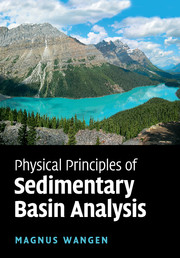Book contents
- Frontmatter
- Contents
- Preface
- Acknowledgments
- 1 Preliminaries
- 2 Properties of porous media
- 3 Linear elasticity and continuum mechanics
- 4 Compressibility of rocks and sediments
- 5 Burial histories
- 6 Heat flow
- 7 Subsidence
- 8 Rheology: fracture and flow
- 9 Flexure of the lithosphere
- 10 Gravity and gravity anomalies
- 11 Quartz cementation of sandstones
- 12 Overpressure and compaction: exact solutions
- 13 Fluid flow: basic equations
- 14 Fluid flow: basic equations
- 15 Wells
- Appendix: Fourier series, the discrete Fourier transform and the fast Fourier transform
- References
- Index
10 - Gravity and gravity anomalies
Published online by Cambridge University Press: 07 May 2010
- Frontmatter
- Contents
- Preface
- Acknowledgments
- 1 Preliminaries
- 2 Properties of porous media
- 3 Linear elasticity and continuum mechanics
- 4 Compressibility of rocks and sediments
- 5 Burial histories
- 6 Heat flow
- 7 Subsidence
- 8 Rheology: fracture and flow
- 9 Flexure of the lithosphere
- 10 Gravity and gravity anomalies
- 11 Quartz cementation of sandstones
- 12 Overpressure and compaction: exact solutions
- 13 Fluid flow: basic equations
- 14 Fluid flow: basic equations
- 15 Wells
- Appendix: Fourier series, the discrete Fourier transform and the fast Fourier transform
- References
- Index
Summary
The gravitational acceleration is often taken to be the constant g = 9.8 ms-2, although this is not quite accurate. The value of g depends on where on the planet it is measured, because the Earth is not a perfect sphere and also because the Earth is rotating. There are also small regional and local variations in g due to density variations in the subsurface. These small variations in g can be measured with a great deal of precision, and they are an important source of information about the distribution of mass (or density) in the subsurface. Figure 10.1 shows an example of a gravity anomaly measured along the sea surface (free-air gravity). The sea bed is smooth and cannot explain the observed gravity. The increased gravity turns out to be caused by a ridge of crustal rocks with a density larger than the surrounding sedimentary rocks.
Differences in g over mountains are closely linked to the concept of isostasy. Measurements show that g is less in high mountain areas than close to sea level. One might easily have guessed the opposite – that gravity would be higher in the mountains since they are large masses of rock. We have seen that isostatic equilibrium means that there is the same mass in all columns down to the same depth in the ductile mantle. Each column is simply floating on the ductile mantle, and a column in the mountains therefore needs deep crustal roots of “low” density to float high compared to areas close to sea level. The mass of the mountains is compensated by a mass deficiency in the crust below.
- Type
- Chapter
- Information
- Physical Principles of Sedimentary Basin Analysis , pp. 316 - 360Publisher: Cambridge University PressPrint publication year: 2010



